Nintendo DS Lite – Handheld Console Review
Nintendo DS Lite – Handheld Console
Nintendo's DS ugly duckling comes of age and turns into the proverbial swan.
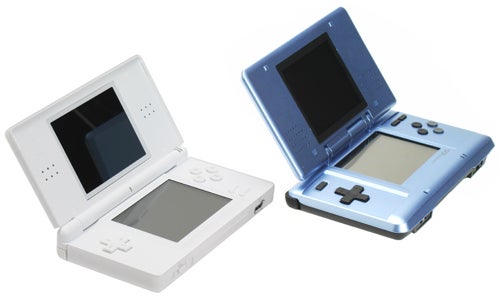
Verdict
Key Specifications
- Review Price: £99.00
When Nintendo released the DS handheld console it faced a major problem – the Sony PSP. Not only did Sony’s new console sport PlayStation branding, but it also gave Nintendo an object lesson in design methodology. Put simply, the PSP looked awesome and instilled all onlookers with a desire to own one, and that was before you even considered the superior graphics, sound and multimedia functionality. Yes, the PSP had the DS out-gunned in pretty much every area, but there’s no doubt that the aesthetics of the DS were its biggest drawback.

Even die hard Nintendo fans like myself had to admit that the DS was, for want of a better word, ugly. At the time of its arrival I went as far as saying that I thought the DS looked like a Chinese knock-off, rather than an official Nintendo console. And as if the overall design wasn’t bad enough, both the screens in the DS were dull, while the touch screen had a quite frankly awful viewing angle. Again, when you compared the two screens in the DS to the single screen in the PSP there was no competition – the screen on the PSP was bright, vibrant and a joy to behold.
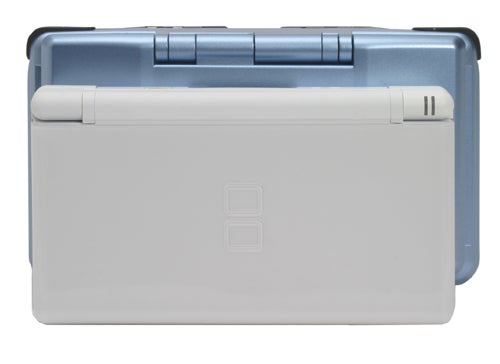
Despite my early misgivings about the DS, I was ever confident that Nintendo would come up with a better version, and that we’d all be asking ourselves why this new machine wasn’t launched in the first place. After all, that’s exactly what Nintendo did with the GameBoy Advance. The original GameBoy Advance was a huge step forward from the GameBoy, but Nintento’s decision to stick with a non-backlit screen proved something of a disaster, while the form factor made the Advance less pocketable than the outgoing machine. But when the GameBoy Advance SP arrived, everything was different. Not only did you get a better quality backlit screen, but the clamshell design made the new console smaller and more stylish. Now Nintendo has done the same thing with the DS and the new DS Lite really does make me ask the question – why wasn’t the original DS like this?
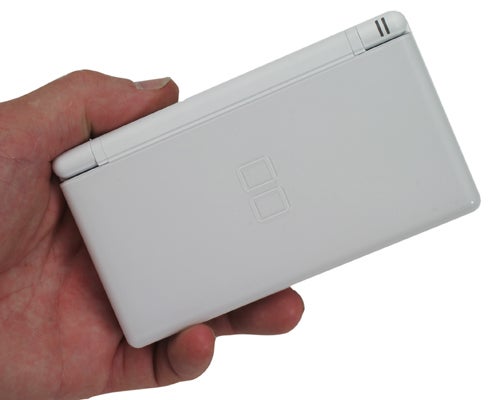
The Nintendo DS Lite looks beautiful. If Apple were ever to make a handheld gaming console it would look like this. In fact I can’t imagine that even Apple’s California design studio could come up with a machine that looks better than the DS Lite, it really is THAT cool. Although the DS Lite is available in different colours, it’s the lacquered white finish that shows Nintendo’s new baby off to best effect, hence the obvious Apple comparisons. I’ve only had my review sample a couple of days, but even now I find myself just holding the DS Lite in my hands, admiring the clean lines and smooth surface. However much Nintendo paid its designers to come up with the DS Lite, it wasn’t enough!
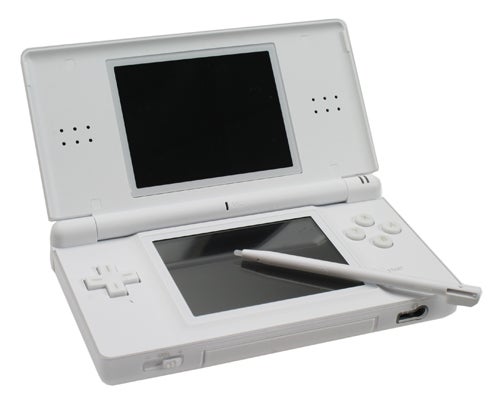
But the DS Lite’s beauty is far from skin deep. As I already mentioned, the dual screens in the original DS were pretty lacklustre, but Nintendo has addressed this issue. Not only are the screens far brighter in the DS Lite, but they look subjectively sharper, while the viewing angle is light years ahead of the older displays. The touch screen is especially impressive, considering how dull it was before, while the improvement in viewing angle is nothing short of staggering – the picture below shows how the touch screen looks like it’s switched off on the old DS.
You can set four levels of brightness for the screens, with level one being roughly equivalent to the original DS. Obviously the screen brightness has an effect on battery life, but even with the brightness set to maximum, you’re still looking at around eight hours of play time – that’s more than double what you could expect from a PSP. To be honest I actually found the top setting too bright, and was very happy with level three, or even two, so I’ll probably be looking at well over 10 hours battery life – that’s level three in the picture.
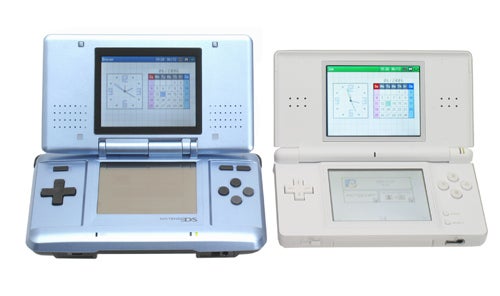
The buttons and controls have all undergone an overhaul as well. Despite being smaller, the D-pad on the DS Lite is far more tactile and offers far better control, especially if you’re trying to pull off something tricky. Conversely, the Y, X, A and B buttons are all slightly larger than on the original DS, but like the D-pad, there’s more travel than before, making the buttons feel more like a full size console controller.
The Start and Select buttons have been moved from above the Y, X, A and B buttons, to below them. This allegedly makes them more easily accessible, but I’m not convinced that it makes much difference either way. Finally the power button that resides above the D-pad on the original DS has gone completely on the Lite, replaced by a sliding power switch on the right hand edge – definitely a far more elegant solution.
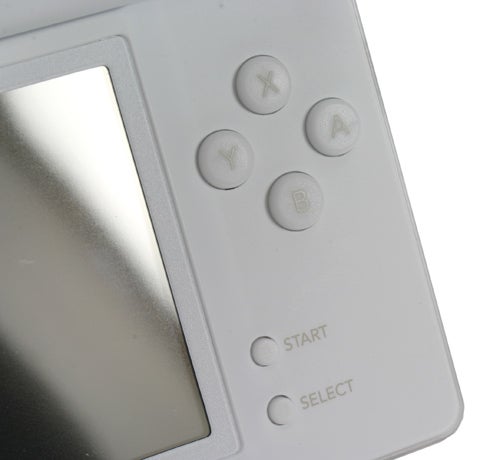
Talking of elegance, there’s no gaping hole at the front of the DS Lite. The original DS had a large hole at the front for inserting GameBoy Advance cartridges, but it was prone to collecting dust and debris when you weren’t playing a GBA game. That’s not to say that the DS Lite can’t handle GBA cartridges because it can. It’s just that this time around Nintendo has seen fit to provide a blanker in order to stop dust ingress and make sure that the clean lines remain uninterrupted. Of course those lines are spoiled when you insert a GBA cartridge since it will protrude from the front of the case, but then I don’t find myself playing GBA games that often on my DS anyway.
Just like on the original DS, the GBA cartridge slot is flanked by the sliding volume control on the left and the headphone socket on the right. The microphone has also been moved from the front of the casing and now resides at the centre of the hinging mechanism between the two screens.
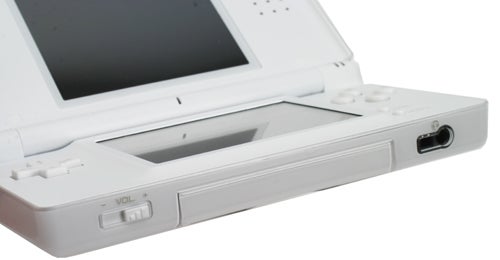
Despite being smaller than the original DS – Nintendo claims that the Lite is less than two thirds the size – and lighter by approximately 20 per cent, the stylus is larger, both in length and diameter. The stylus on the DS Lite slides out of the right side of the casing rather than the rear as with the original. The extra length and girth of the new stylus really does make it easier to hold and consequently easier to control your games.
The two shoulder buttons are of course in the same place, and although they don’t posses as much travel as the examples on the original DS, they do exhibit a reassuring click when pressed, while the originals were a little bit woolly when it came to feedback. The DS cartridge slot at the rear is pretty much identical to the older model – pressing the cartridge in locks it in place, while pressing it again will eject it.
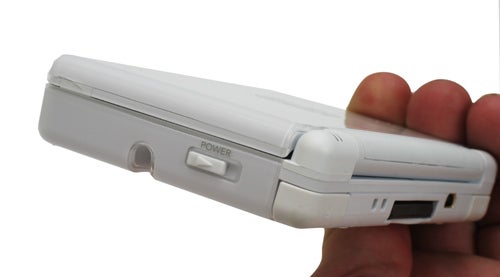
At this point in the review all those PlayStation fan boys (and girls) are probably shrugging their shoulders in a kind of “so what?” fashion. So what if the DS Lite looks a million times better than the original, the games are still rubbish compared to the PSP right? Wrong!
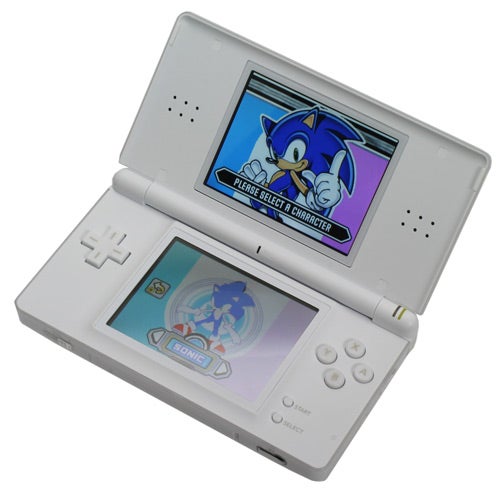
Doing what I do for a living I have no shortage of gaming hardware and software at my disposal. I see a regular stream of Sony PSP games land on my desk, but for the past six months or so I’ve spent a lot more time playing my DS than I have my PSP. The reason for this is simple – there are games on the DS that are fun. That’s right, fun, pure, unadulterated fun. I’m not denying that Grand Theft Auto on the PSP is superb, because it is and I’ve spent a lot of time playing it. But with the PSP you essentially have a home console in the palm of your hands, with games that are just as big and complicated as they are on a full size machine. With the DS things are just that bit simpler.
Look at Super Monkey Ball: Touch & Roll. If ever a game was designed for touch screen control it’s this one. Then throw in Nintendogs (the game that finally convinced me to buy a DS, even though I knew that the DS Lite was on the way) – not only is this game innovative, but it has the honour of being the only video game that has ever made me feel guilty. With Nintendogs the clock keeps ticking even when the machine is off, so if you don’t look after your puppy regularly she’s gonna feel neglected!
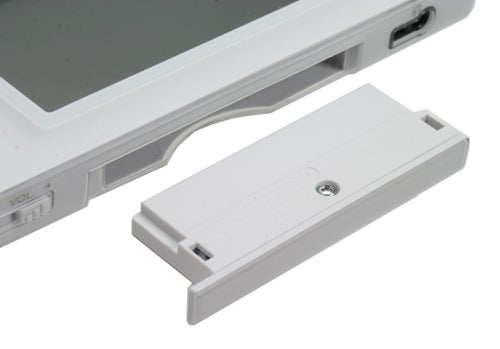
Then when you look at classic Nintendo properties like Mario Kart, things start to look rosy indeed. With Mario Kart Nintendo also instigated Internet multi-play, matching one of the PSP’s big features. Then slap in a game like Sega’s Project Rub and you get a real feeling for the capabilities of Nintendo’s machine while you tap, rub, shout and blow your way through some of the most bizarre gaming environments you’re ever likely to encounter.
In defence of the PSP, there have been some games which can compete with the DS for serious fun. OutRun 2006 for example was an absolute riot, and I’m still playing it now. But one thing you have to remember is that just because the PSP games look better, it doesn’t necessarily mean they are better. Ultimately you’re talking about two very different approaches to handheld gaming, and there’s no real right or wrong, just a matter of preference.
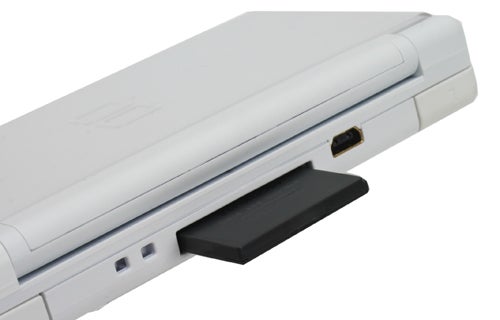
One thing that is annoying about the DS Lite is that it uses a different power supply to the original DS. Given, it is the same PSU as the GBA Micro, but that’s not going to help current DS owners that want to upgrade and fancy having a PSU at work and at home.
Although it’s been available in Japan for a while (in a wide variety of colours) the DS will be hitting UK streets on the 23rd of June in either black or white finish. Despite the major overhaul, Nintendo has managed to keep the price of the DS Lite in a similar ball park to the older model, with a recommended price of £99. That’s pretty tempting considering you’re still looking at around £179 for the mid range PSP pack.
Now the big question is do I replace my perfectly good DS with a glossy white DS Lite? Stupid question really!

”’Verdict”’
This is exactly what the original DS should have been – if Nintendo had produced a machine like this a year and a half ago, Sony would have had a much tougher time convincing buyers to cough up £180. The DS Lite looks stunning, feels great in the hand and has a catalogue of great, if sometimes surreal games. If you’ve been putting off buying a Nintendo DS because you thought it was ugly, you don’t have that excuse anymore, and at £99 you’ll be getting a bargain.

